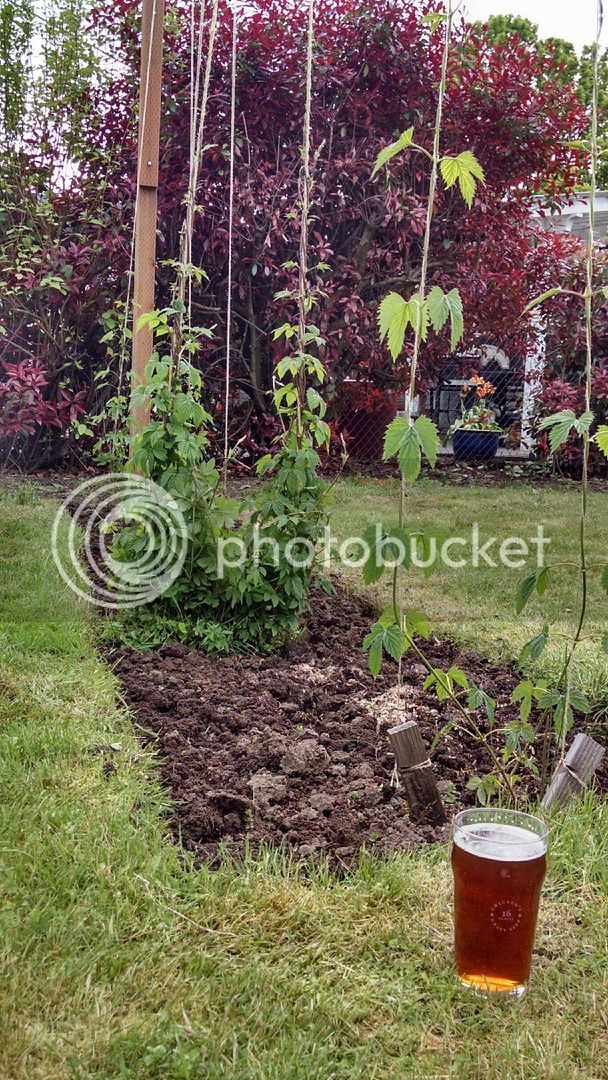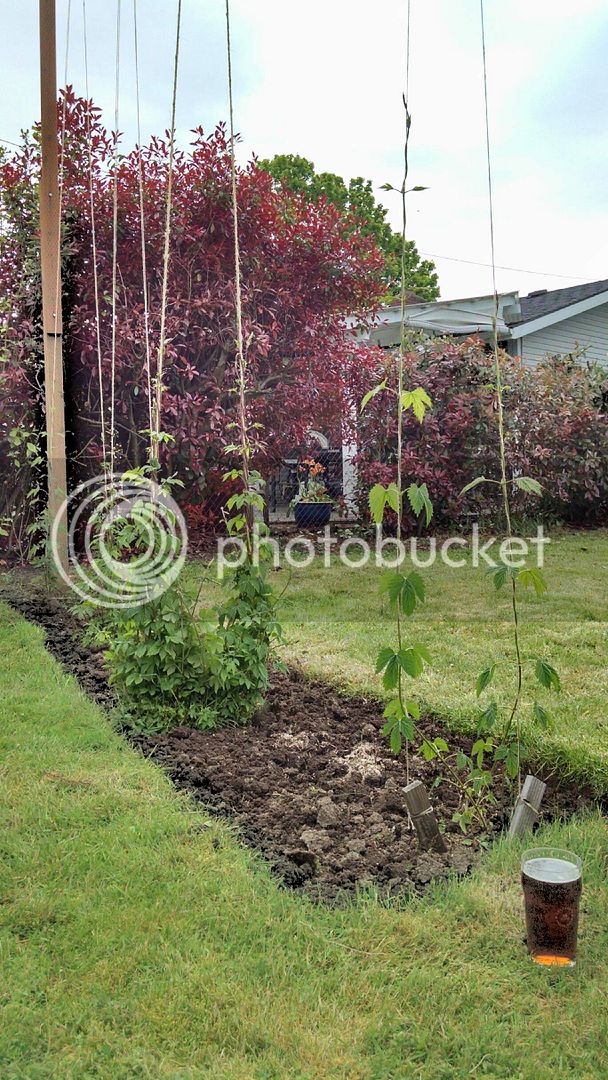Here's a pic of my first Cascade cones, earlier than ever. Crappy pic, I had to hold the bine still with one hand because of the wind.
View attachment 1492635463369.jpg
View attachment 1492635463369.jpg

The snow just melted off the top of mine.....
How much weight are you all harvesting per plant (wet), with these backyard hops? Trying to figure out how much I'll have to brew to use all of mine
Rupert, I've done that, not on purpose, it didn't make much difference. I harvest continually from June until November
Rupert, I've done that, not on purpose, it didn't make much difference. I harvest continually from June until November
The Cascade and Chinook came up weeks ago... the Horizon and Magnums did notwas hoping they would come back...
I always cut mine back until May 1st based on the advice of commercial hop growers. It sets them up to start flowering right at the end of June. You're supposed to get a bigger yield doing it this way. Also prevents the hops from going brown in the heat of the summers longest days.
How long do you let the bines go before you cut them? Do you cut them once the emerge?
I let mine grow to about a foot long and then cut them, if they get that long before May.
How long do you let the bines go before you cut them? Do you cut them once the emerge?
I let mine grow to about a foot long and then cut them, if they get that long before May.


I'm in the ATL area as well - my Centennial is barely a foot off the ground. It does not appear to want to climb onto my guide wire (it is a synthetic 5/16" rope with plenty of 'roughness' for the bines to lock onto)
Wondering if i should clip some of the side shoots to encourage the main bines to grow...
Mine are 5 or 6 feet at least...
I can't imagine having my hops producing multiple harvests like the OP. I hope I can get some cones to harvest this year. Last year I just let them grow and they produced cones, but not many but I knew that being their first year.
View attachment 398105
View attachment 398106
Honestly...other the initial set up...good soil etc...I do next to nothing...this is the coolest spot I could find...
So my spot has great morning sun, gets light from 7:00AM through 3:00PM, and has several cubic feet of amazing soil.
Just first season blues?
I can't imagine being able to just dig grass from around my hops and having clean soil. We are infested with Bermuda grass down here, it sends off underground runners so it can never be eradicated with anything short of a tactical nuclear bomb. That's why I end up cutting some bines with a weedwhacker every year. The last time I replaced my pool liner there were Bermuda roots 1/4 inch in diameter running the length of the pool, nothing stops this stuff.
You've never dealt with Bermuda grass, it is it's own special category. To remove it temporarily I have to dig all the dirt out, down to a depth of at least 25 cm, run the dirt through a sifter and put it back in place. But within a month the grass is back. I live in the desert(kind of). If I go to a section of yard that is only dirt, no grass or weeds within 20 meters, and I pour water on the ground, within 2 weeks a Bermuda grass runner will find it. It goes through plastic weed barriers, plastic sheeting, it is unstoppable. Rototilling just chops the roots into smaller pieces and redistributes them. If we don't get rain for 6 months(not uncommon) the grass turns brown and disappears completely, but a 15 minute shower turns the grass green again in a week.Don't underestimate the power of pulling weeds! Including grass. Pull it enough, break it enough, and it will die. After an initial blitz (few weeks), taking care of invading rhizomes, stolons, and seeds will be less hassle. All feasible if you just have a few plants and the patience for it.
Plastic barriers can help, though. Or bottomless pots.
Well, not everyone has my patience (or zeal?) for weeding. I've worked on farms, I've spent days and days manually weeding fields between plants on the rows, as well as to make fallows cultivatable. Takes time and work, but it's hardly impossible.
People tend to not like weeding, and do half-assed jobs. To win against weeds, persistence is required. Some species can actually proliferate faster as a result of botched weeding.
Rhizomes are food stockpiles. Growth drains these stockpiles. Photosynthesis renews them. You gotta deplete the stockpiles to win, which means *frequent* weeding, otherwise the leaves will make enough photosynthesis to compensate for your efforts. Seeds are of no concern with frequent weeding. Seedlings of all species are fragile. Chop that rootlet, it dies. And since it depends a lot on surface humidity, standard hoeing suffices, don't even need to pull on it.
It's the same principle for all species. Some just require more frequency than others. The only thing that differs between aggressive weeds is what will happen if you fail. In commercial fields, some of these weeds are problematic because the labor required is too expensive. But for a couple of plants in the backyard? Everyone needs a bit of fresh air...
I love the confidence of ignorance! If you have never dealt with Bermuda grass then you are totally clueless and really have no business putting me down for just being lazy.It's the same principle for all species.
I always cut mine back until May 1st based on the advice of commercial hop growers. It sets them up to start flowering right at the end of June. You're supposed to get a bigger yield doing it this way. Also prevents the hops from going brown in the heat of the summers longest days.
Hmm, maybe I should have practiced the same. Mine are looking pretty rough after the weather we've had the past week. I think another hard freeze is coming tonight. Some of mine are over 6' tall already. I wonder if I should cut back and start over...
I just weeded my hop bed today. No Bermuda grass here, thank you Jesus


I am a long way from my beds looking like that, but man yours look fantastic.

Enter your email address to join: